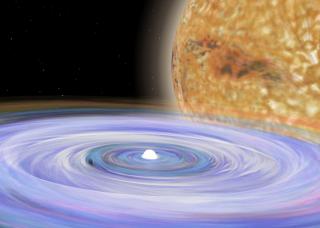Bibcode
Green, M. J.; Hermes, J. J.; Marsh, T. R.; Steeghs, D. T. H.; Bell, Keaton J.; Littlefair, S. P.; Parsons, S. G.; Dennihy, E.; Fuchs, J. T.; Reding, J. S.; Kaiser, B. C.; Ashley, R. P.; Breedt, E.; Dhillon, V. S.; Gentile Fusillo, N. P.; Kerry, P.; Sahman, D. I.
Referencia bibliográfica
Monthly Notices of the Royal Astronomical Society, Volume 477, Issue 4, p.5646-5656
Fecha de publicación:
7
2018
Número de citas
22
Número de citas referidas
21
Descripción
We present the discovery of SDSS J135154.46-064309.0, a short-period
variable observed using 30-mincadence photometry in K2 Campaign 6.
Follow-up spectroscopy and high-speed photometry support a
classification as a new member of the rare class of ultracompact
accreting binaries known as AM CVn stars. The spectroscopic orbital
period of 15.65 ± 0.12 min makes this system the
fourth-shortest-period AM CVn known, and the second system of this type
to be discovered by the Kepler spacecraft. The K2 data show photometric
periods at 15.7306 ± 0.0003 min, 16.1121 ± 0.0004 min, and
664.82 ± 0.06 min, which we identify as the orbital period,
superhump period, and disc precession period, respectively. From the
superhump and orbital periods we estimate the binary mass ratio q =
M2/M1= 0.111 ± 0.005, though this method of
mass ratio determination may not be well calibrated for helium-dominated
binaries. This system is likely to be a bright foreground source of
gravitational waves in the frequency range detectable by Laser
Interferometer Space Antenna, and may be of use as a calibration source
if future studies are able to constrain the masses of its stellar
components.
Proyectos relacionados

Estrellas Binarias
El estudio de las estrellas binarias es una parte esencial de la astrofísica estelar. Una gran parte de las estrellas de nuestra Galaxia y de otras galaxias se ha formado en sistemas binarios o múltiples, por lo que entender la estructura y evolución de estos sistemas es importante desde el punto de vista estelar y galáctico. Un aspecto en el que
Pablo
Rodríguez Gil